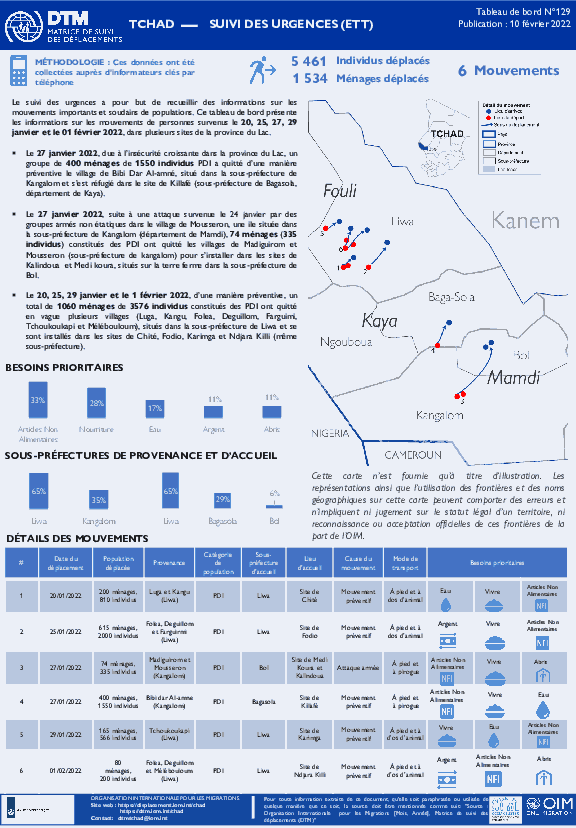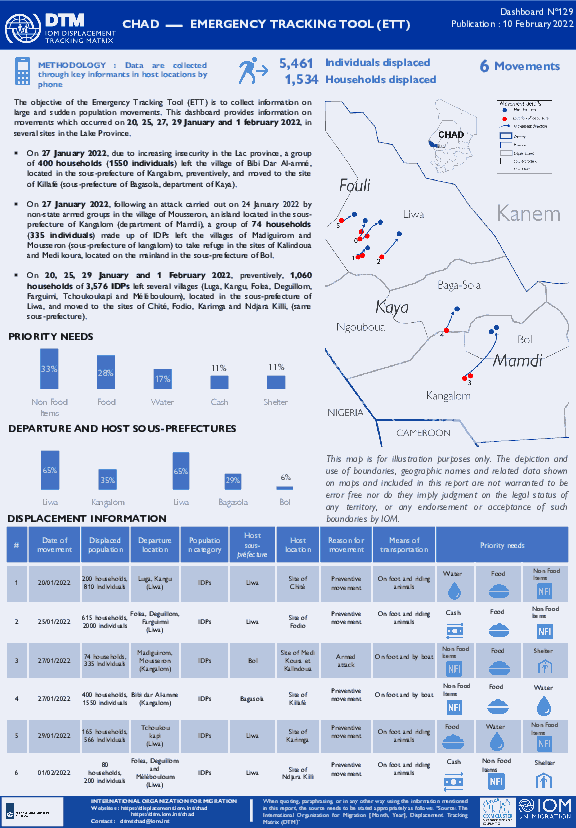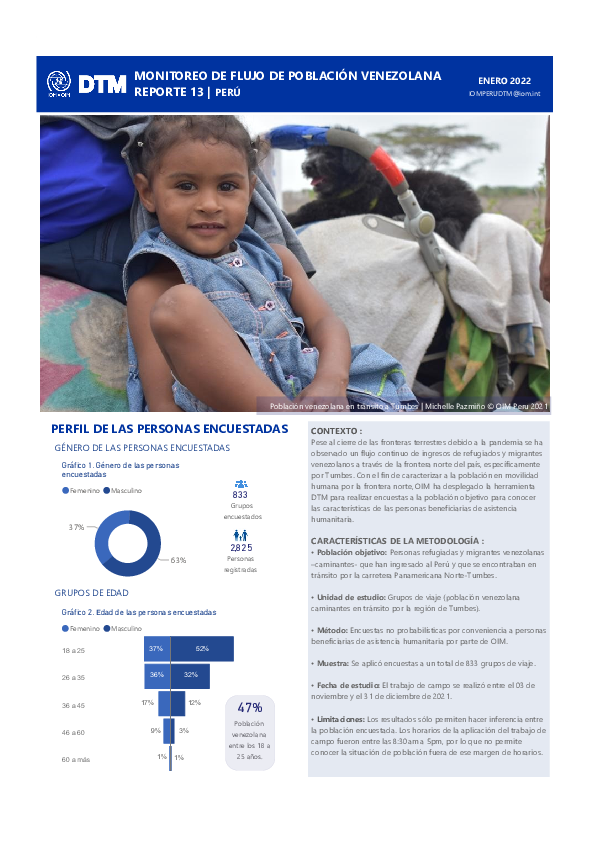-
Countries
-
Data and Analysis
-
Special Focus
-
Crisis Responses

Contact
DTM Djibouti, DTMDjibouti@iom.int
Language
French
Location
Djibouti
Period Covered
Jan 01 2022
Jan 31 2022
Activity
- Survey
- Flow Monitoring Survey
- Flow Monitoring
- Migrants presence
Ce tableau de bord présente les principales tendances migratoires observées à Djibouti en janvier 2022. Il vise à fournir une vue d'ensemble des principales dynamiques migratoires au niveau de Djibouti, en présentant des analyses à la fois quantitatives et qualitatives obtenues à travers plusieurs outils de collectes de données développées par l'OIM Djibouti.
Ce tableau de bord comprend:
- Une mise à jour mensuelle des principales données obtenues à travers l’enregistrement des flux aux 10 points de suivi des flux (FMP) actifs à Djibouti;
- Des données clés sur les retours spontanés du Yémen ainsi que sur les mouvements entre Djibouti et l'Éthiopie;
- Une mise à jour mensuelle sur les profils, vulnérabilités, parcours migratoires et intentions des personnes interrogées à travers les enquêtes individuelles (FMS);
- Une mise à jour sur la présence des migrants bloqués à Djibouti.

Contact
DTM Djibouti, DTMDjibouti@iom.int
Language
English
Location
Djibouti
Period Covered
Jan 01 2022
Jan 31 2022
Activity
- Survey
- Flow Monitoring Survey
- Flow Monitoring
- Migrants presence
This dashboard presents the main migration trends observed in Djibouti in January 2022. It aims to provide an overview of the main mobility trends in Djibouti, through both quantitative and qualitative analyses, obtained from several data collection tools developed by IOM Djibouti.
This dashboard includes:
- A monthly update on the key data obtained through the Flow Monitoring Registry (FMR) at the 10 active Flow Monitoring Points (FMPs) in Djibouti;
- Key data on spontaneous returns from Yemen and movements observed between Djibouti and Ethiopia;
- Anmonthly update on the profile, vulnerabilities, migratory experience and intentions of the migrants surveyed through the Flow Monitoring Surveys (FMS);
- An update on the presence of migrants stranded in Djibouti.
Contact
DTM Yemen, iomyemendtm@iom.int
Location
Yemen
Activity
- Event Tracking
- Mobility Tracking
Period Covered
Feb 06 2022 -Feb 12 2022
From 01 January 2022 to 12 February 2022, IOM Yemen DTM estimates that 3,054 households (HH) (18,324 Individuals) have experienced displacement at least once.
Since the beginning of 2022, DTM also identified 10 displaced households who left their locations of displacement and either moved back to their place of origin or another location.
Between 06 and 12 February 2022, IOM Yemen DTM tracked 329 households (1,974 individuals) displaced at least once. The top three governorates and districts where people moved into/within are:
• Al Hodeidah (121 HH) – Hays (97 HH), Al Khukhah (24 HH) districts. Most displacements in the governorate were internal.
• Shabwah (78 HH) – Ataq (52 HH), Bayhan (11 HH), Osaylan (9 HH) districts. Most displacements in the governorate originated from Shabwah and Ibb.
• Taiz (54 HH) – Jabal Habashi (45 HH), Al Maafer (6 HH), Al Misrakh (3 HH) districts. Most displacements in the governorate were internal.
Most displacements resulted from the increased conflict in the following governorates and districts.
• Al Hodeidah (129 HH) – Hays (82 HH), At Tuhayta (23 HH), Bayt Al Faqih (12 HH) districts.
• Taiz (71 HH) – Jabal Habashi (41 HH), Maqbanah (24 HH), Sharab Ar Rawnah (2 HH) districts.
• Shabwah (39 HH) – Bayhan (16 HH), Ayn (13 HH), Osaylan (10 HH) districts.
Population Groups
Survey Methodology
Unit of Analysis Or Observation
Type of Survey or Assessment
Keywords
Geographical Scope
Administrative boundaries with available data
The current dataset covers the following administrative boundaries

Contact
DTMAFGHANISTAN@iom.int
Language
English
Location
Afghanistan
Period Covered
May 05 2021
Jul 27 2021
Activity
- Points of Entry (PoE)
The COVID-19 pandemic has resulted in unprecedented containment policies to restrict global human mobility in order to prevent the spread of the virus. To better understand how COVID-19 affects global, national, and sub-national mobility, IOM has developed a global mobility database to map, track and analyze the impact of the COVID-19 pandemic on Points of Entry (PoE).
IOM Afghanistan's COVID-19 Impact on Points of Entry Report is meant to serve IOM Member States, IOM, UN and voluntary partner agencies, civil society and the media, as well as the general population, to better understand the present conditions, restrictions and response gaps at PoE. DTM in Afghanistan has been regularly monitoring PoEs throughout the pandemic, since March 2020, utilizing a range of knowledgeable key informants, including International Health Regulations (IHR) officials from the Ministry of Public Health, border officials, cross-border communities, and IOM teams working at key border crossing points. This report is accurate to the best of IOM’s knowledge at the time of compilation. The analysis is always dated and timestamped in order to reflect the reality at a given time. However, as the situation at PoE continuously evolves and changes, despite IOM’s best efforts, the analysis may not always accurately reflect the multiple and simultaneous restrictive measures being imposed at a specific location.

Contact
DTM Tchad, dtmtchad@iom.int
Language
French
Location
Chad
Snapshot Date
Feb 01 2022
Activity
- Event Tracking
- Mobility Tracking
Le suivi des urgences a pour but de recueillir des informations sur les mouvements importants et soudains de populations. Ce tableau de bord présente les informations sur les mouvements de personnes survenus le 20, 25, 27, 29 janvier et le 01 février 2022, dans plusieurs sites de la province du Lac.
Le 27 janvier 2022, due à l’insécurité croissante dans la province du Lac, un groupe de 400 ménages de 1550 individus PDI a quitté d’une manière préventive le village de Bibi Dar Al-amné, situé dans la sous-préfecture de Kangalom et s’est réfugié dans le site de Killafé (sous-préfecture de Bagasola, département de Kaya).
Le 27 janvier 2022, suite à une attaque survenue le 24 janvier par des groupes armés non étatiques dans le village de Mousseron, une ile située dans la sous-préfecture de Kangalom (département de Mamdi), 74 ménages (335 individus) constitués des PDI ont quitté les villages de Madiguirom et Mousseron (sous-préfecture de kangalom) pour s’installer dans les sites de Kalindoua et Medi koura, situés sur la terre ferme dans la sous-préfecture de Bol.
Le 20, 25, 29 janvier et le 1 février 2022, d’une manière préventive, un total de 1060 ménages de 3576 individus constitués des PDI ont quitté en vague plusieurs villages (Luga, Kangu, Folea, Deguillom, Farguimi, Tchoukoukapi et Mélébouloum), situés dans la sous-préfecture de Liwa et se sont installés dans les sites de Chité, Fodio, Karimga et Ndjara Killi (même sous-préfecture).

Contact
DTM Chad, dtmtchad@iom.int
Language
English
Location
Chad
Snapshot Date
Feb 01 2022
Activity
- Event Tracking
- Mobility Tracking
The objective of the Emergency Tracking Tool (ETT) is to collect information on large and sudden population movements. This dashboard provides information on movements which occurred on 20, 25, 27, 29 January and 1 february 2022, in several sites in the Lake Province.
On 27 January 2022, due to increasing insecurity in the Lac province, a group of 400 households (1550 individuals) left the village of Bibi Dar Al-amné, located in the sous-prefecture of Kangalom, preventively, and moved to the site of Killafé (sous-prefecture of Bagasola, department of Kaya).
On 27 January 2022, following an attack carried out on 24 January 2022 by non-state armed groups in the village of Mousseron, an island located in the sous-prefecture of Kangalom (department of Mamdi), a group of 74 households (335 individuals) made up of IDPs left the villages of Madiguirom and Mousseron (sous-prefecture of kangalom) to take refuge in the sites of Kalindoua and Medi koura, located on the mainland in the sous-prefecture of Bol.
On 20, 25, 29 January and 1 February 2022, preventively, 1,060 households of 3,576 IDPs left several villages (Luga, Kangu, Folea, Deguillom, Farguimi, Tchoukoukapi and Mélébouloum), located in the sous-prefecture of Liwa, and moved to the sites of Chité, Fodio, Karimga and Ndjara Killi, (same sous-prefecture).

Contact
DTM Mali, DTMMali@iom.int
Language
French
Location
Mali
Period Covered
Dec 07 2021
Dec 31 2021
Activity
- Survey
- Migrants presence
L’OIM, en collaboration avec l’Institut National de la Statistique du Mali (INSTAT), a mis en œuvre une enquête dite de Présence des Migrants en décembre 2021. Cette enquête a pour objectif de mettre en lumière les tendances, profils, vulnérabilités et besoins spécifiques des populations migrantes afin de mettre en place un cadre spécifique en faveur de la protection des migrants, de la lutte contre la traite et de la promotion d’un retour sûr et digne en vue d’une réintégration durable.
Cette enquête s’est déroulée dans les régions de Kayes et Sikasso où, selon l’Enquête Modulaire Permanente Auprès des Ménages (EMOP) de l’INSTAT réalisée chaque année, une population migrante importante vie dans ces régions.
Sur la base de la population totale des migrants économiques des trois régions retenues, un échantillon de 1 116 de ces migrants a été sélectionné. La taille de cet échantillon a été répartie proportionnellement à la taille de la population migrante de chacune des communes des régions retenues.

Contact
DTMMozambique@iom.int
Language
English
Location
Mozambique
Period Covered
Feb 02 2022
Feb 08 2022
Activity
- Event Tracking
- Mobility Tracking
Initial attacks in Meluco district by Non-State Armed Groups (NSAGs) were reported on 4 January 2022. Recent attacks in Muaguide posto - (Mitemba, Sitate, and Iba) triggered the movements of 2,955 individuals to Cidade de Pemba between 02-08 February 2022. Ninety-nine IDPs have been identified with vulnerabilities: 56 elderly individuals, 24 pregnant women, 12 persons with disabilities, and 7 unaccompanied minors. The arrival of displaced populations from Meluco within this reporting period have been mapped in Josina Machel, Natite, Mahate, Cariaco, Maringanha, Paquitequete, Metula and Mondalane, accumulatively recording an estimated 4, 104 Meluco arrival movements in Cidade de Pemba between 28 January - 08 February. For further information on the needs and conditions faced by 1,265 households arriving from Meluco in IOM CCCM managed sites of Ancuabe, Chiure, Montepuez and Metuge (cumulative observed arrivals as of 07 February),

Contact
DTMMozambique@iom.int
Language
English
Location
Mozambique
Period Covered
Feb 02 2022
Feb 08 2022
Activity
- Event Tracking
- Mobility Tracking
During the reporting period (2nd to 8 February 2022), a total of 60 movements were recorded - 53 Arrivals (4,629 individuals), 1 departures (20 individuals), 1 return (52 individuals) and 5 transits (419 individuals). The largest arrival movements were recorded in Cidade de Pemba (3,207 individuals), Nangade (417 individuals), Ibo (335 individuals).The largest return was observed in Mueda (52 individuals). The largest transit was observed in Mueda (401 individuals). For further information on the needs and conditions faced by 1,462 households arriving in IOM CCCM managed sites of Ancuabe, Chiure, Montepuez and Metuge.

Contact
DTM Peru, IOMDTMPeru@iom.int
Language
Spanish
Location
Peru
Period Covered
Nov 03 2021
Dec 31 2021
Activity
- Flow Monitoring
Pese al cierre de las fronteras terrestres debido a la pandemia se ha observado un flujo continuo de ingresos de refugiados y migrantes venezolanos a través de la frontera norte del país, específicamente por Tumbes. Con el fin de caracterizar a la población en movilidad humana por la frontera norte, OIM ha desplegado la herramienta DTM para realizar encuestas a la población objetivo para conocer las características de las personas beneficiarias de asistencia humanitaria.